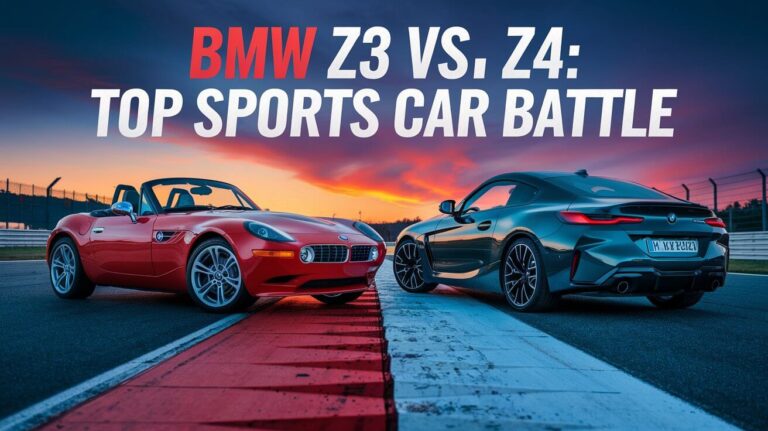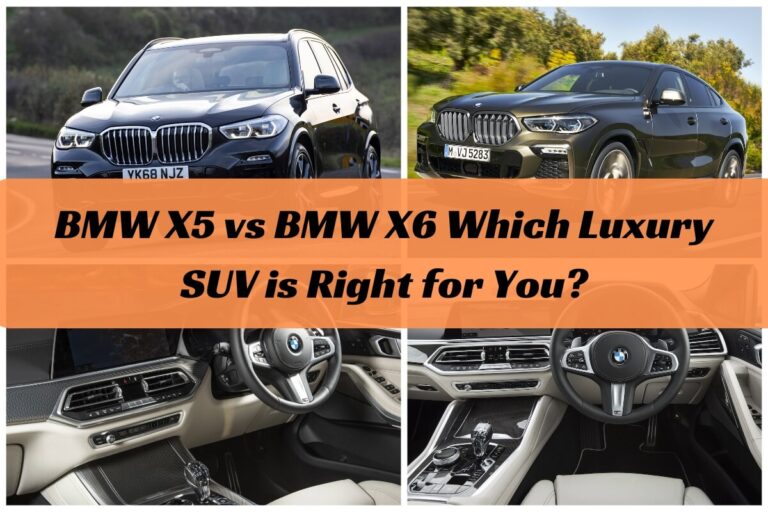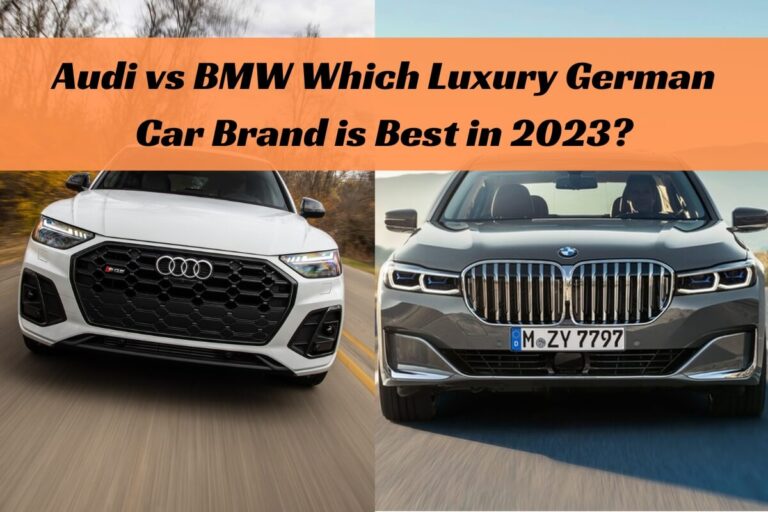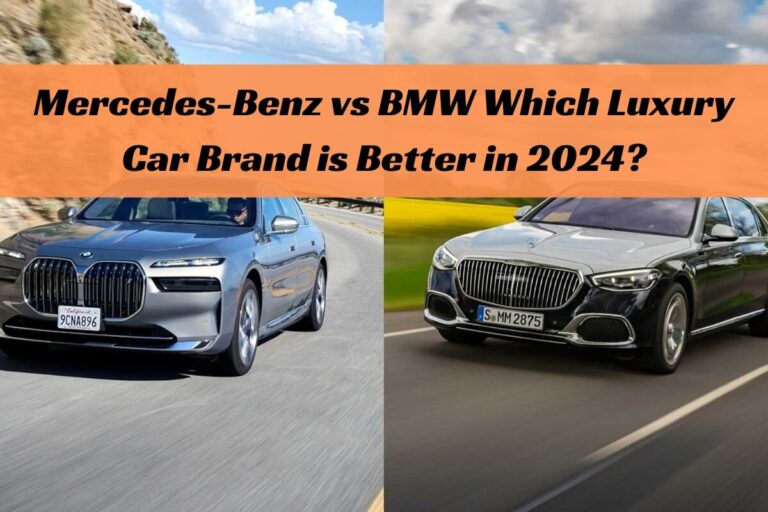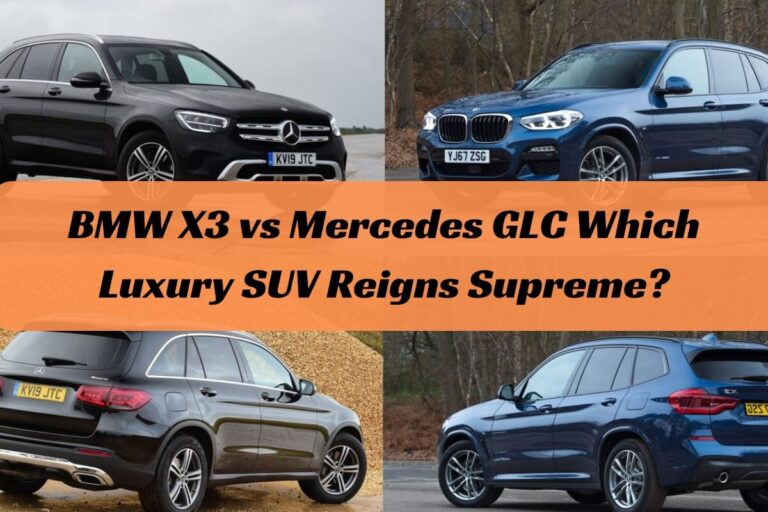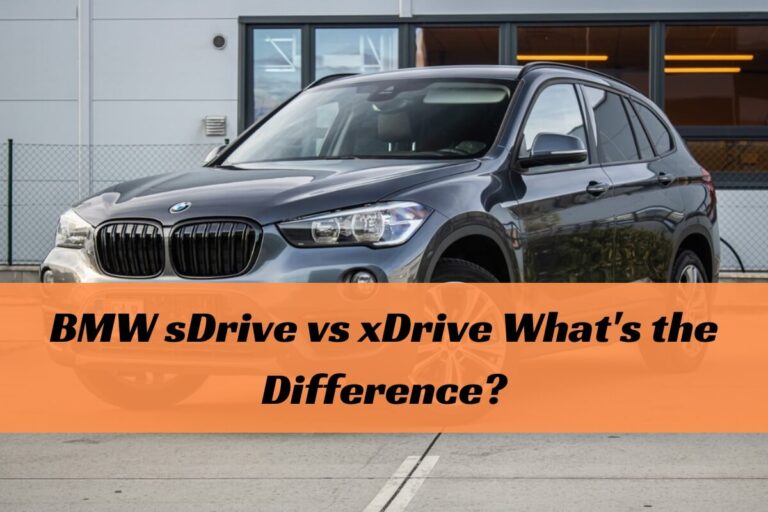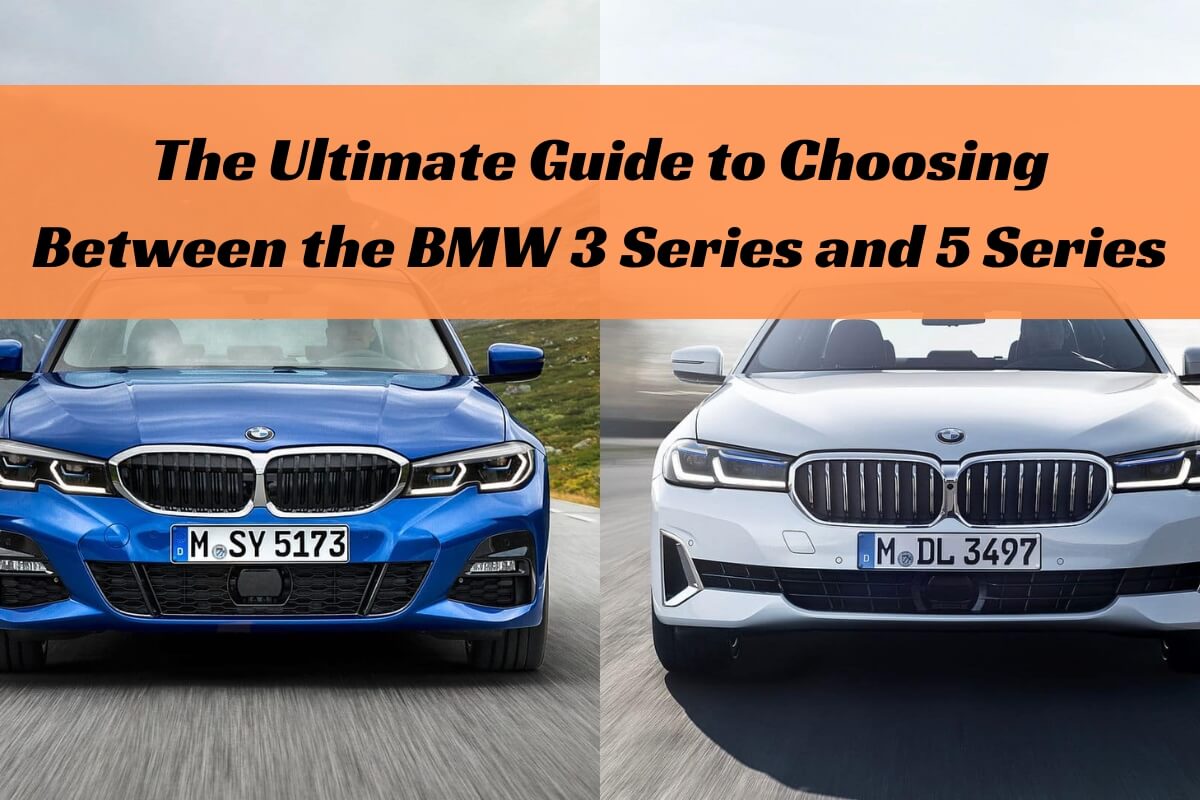
For decades, the BMW 3 Series and 5 Series have been benchmarks for premium German luxury sedans. These two iconic model lines from the Bavarian automaker blend performance, refinement and upscale amenities into packages respected by enthusiasts and luxury buyers alike.
But which BMW is the better choice for you – the smaller yet sportier 3 Series or the larger, more luxurious 5 Series?
In short, the 3 Series offers a more dynamic driving experience in a slightly more affordable package, while the 5 Series leans into comfort and interior space.
This guide covers all the key differences between the BMW 3 Series and 5 Series so you can decide which premium sedan best suits your needs and driving preferences. We’ll dive into how they compare in performance, interior roominess, luxury features, pricing and more.
Overview of the BMW 3 Series and 5 Series
The BMW 3 Series and 5 Series have been around for over 40 years, consistently setting the bar for compact executive cars and midsize luxury sedans respectively.
The 3 Series traces its roots back to the legendary BMW 2002 from the 1960s. First launched in 1975, it quickly became one of the brand’s top-selling model lines thanks to its ideal blend of performance, premium features and reasonable pricing. Now in its seventh generation, the current G20 3 Series models aim to continue that winning formula.
The larger BMW 5 Series kicked off in 1972, initially positioned above the compact 3 Series and below the flagship 7 Series luxury sedan. Over its seven generations spanning five decades, the 5 Series grew to offer more interior space and amenities while still prioritizing driving dynamics. The current G30 5 Series models continue this heritage.
While both offer premium BMW prestige and quality, the 3 Series and 5 Series diverge when it comes to priorities on performance versus luxury. Let’s examine how these two stalwart model lines differ across key areas.
Performance – How Do the 3 Series and 5 Series Compare?
Engine Options and Horsepower Ratings
BMW offers a range of powerful yet refined gasoline, diesel and electrified powertrain options for both the 3 Series and 5 Series lineups. However, there are some key differences in terms of engine choices and performance output.
The 2023 BMW 3 Series offers a 2.0L TwinPower Turbo 4-cylinder in the 330i producing 255 hp and 295 lb-ft torque. For more power, there’s the M340i with a 3.0L TwinTurbo inline-6 making 382 hp and 369 lb-ft torque. The plugin hybrid 330e gets a 2.0L turbo-4 coupled to an integrated electric motor system for a combined 288 hp and 310 lb-ft torque.
For 2023, the BMW 5 Series stable includes the 530i with a 2.0L TwinPower Turbo 4-cylinder producing 248 hp and 258 lb-ft torque. There’s also the 540i with a 3.0L TwinTurbo inline-6 making 335 hp and 331 lb-ft torque. Hybrid options include the 530e plugin with 288 hp and the more powerful 545e xDrive making 389 hp.
While many engine choices overlap, the key difference is the higher performance variants like the M340i give the 3 Series more powerful, sportier options compared to the current 5 Series range.
This ties into how these two BMWs are tuned from the factory. The 3 Series prioritizes sharper, more dynamic driving dynamics while the larger 5 Series is set up with a more refined, comfort-oriented driving experience in mind.
Transmission and Drivetrain Configurations
In the past, BMW offered manual transmissions across some 3 Series and 5 Series models for driving purists. However, all current versions now use automatic gearboxes as the sole transmission choice.
The 3 Series gets an 8-speed automatic transmission across the lineup. Meanwhile, the 5 Series models pair their engines with a crisp-shifting 8-speed Steptronic Sport automatic.
In terms of drivetrain layouts, both sedans are available in rear-wheel drive (RWD) or BMW’s xDrive intelligent all-wheel drive system as options. xDrive can provide enhanced traction and control over slippery conditions.
Interior Space and Comfort
Passenger Room and Cargo Capacity
As you’d expect, the larger BMW 5 Series provides more interior room for passengers and cargo compared to the compact 3 Series sedan. The numbers reveal the difference.
Up front, the 3 Series offers 38.7 inches of headroom and 42 inches of legroom compared to 39.1 inches head clearance and 41.3 inches legroom in the 5 Series. The advantage flips to the larger sedan in rear seat space, with the 5 Series providing 39.1 inches of rear headroom versus 37.6 inches in the 3, and 37 inches rear legroom compared to 35.2 inches.
For carrying cargo, the 3 Series trunk measures 17 cubic feet while the 5 Series ups that to 18.7 cu-ft. Both sedans provide folding rear seats to expand the cargo area when needed. BMW also offers the more practical 3 Series Touring wagon and 5 Series Touring wagon if you need maximum versatility.
Luxury Appointments and Technology
Lavish interior design and the latest tech features are priorities across both the 3 Series and 5 Series lineups. However, the larger 5 Series models do get a few extra luxuries as expected.
Inside, each BMW sedan greets passengers with premium materials like available leather upholstery, wood trim accents, aluminum detailing and more. However, the 5 Series takes it a step further with options like glass controls (Start/Stop button, iDrive controller and transmission gear selector), a full Panoramic Sky Lounge LED roof, and available multi-contour front seats with massage functions. These high-end touches give the 5 Series interior an even more upscale, indulgent ambiance.
Both model lines utilize BMW’s cutting-edge iDrive 8 infotainment system with a crisp digital instrument cluster, a large central touchscreen display, navigation, Wi-Fi hotspot and wireless Android Auto/Apple CarPlay mirroring. The 5 Series gets a larger 14.9-inch touchscreen versus the 3’s 12.3-inch display.
While very well appointed, the BMW 3 Series leans more towards a sportier, driver-focused interior design compared to the overtly luxurious cabin of the 5 Series sedan.
Exterior Styling Differences
On the outside, there’s no mistaking the familial BMW design DNA shared between the brand’s iconic 3 Series and 5 Series sedans. However, each model projects a distinct style and road presence.
In terms of exterior dimensions, the 3 Series has a compact footprint measuring 185.7 inches long, 71.9 inches wide and 57 inches tall. The larger BMW 5 Series casts a bigger shadow at 199.2 inches long, 73.5 inches wide and 58.2 inches high.
Up front, both models feature BMW’s traditional twin kidney grille along with sleek LED headlights. However, the larger grille and sculpted hood of the 5 Series give it a more imposing, prestigious face. Around back, the 5 Series taillights extend slightly further into the rear quarter panels for a wider, more planted stance.
Both sedans offer a sleek, aerodynamic profile and the long hood/short trunk deck proportions that define BMW’s sporty yet elegant design language. While the 3 Series retains an athletic, taut muscularity, the larger 5 Series exudes a more refined, substantial road presence.
As for body style choices, the 3 Series is offered in sedan, Touring wagon and Gran Turismo 5-door liftback layouts. The 5 Series comes as a sedan or more capacious Touring wagon.
Question: Which BMW is More Fuel Efficient?
Given their different powertrains, sizes and curb weights, there is a noticeable difference in fuel economy ratings between the BMW 3 Series and 5 Series model lines.
For the gas engine models in rear-wheel drive configuration, the 2023 3 Series 330i rates 26/36 mpg city/highway while the larger 530i comes in at 25/33 mpg. The diesel-powered models show a similar pattern, with the 2023 330d achieving up to 32/46 mpg compared to 28/39 mpg for the 540d xDrive.
Where the efficiency scales really tip in favor of the smaller 3 Series are the plug-in hybrid variants. The 2023 330e can travel up to 23 miles on electric power alone and achieves 75 MPGe combined gas/electric ratings. Meanwhile, the larger 530e PHEV rates 64 MPGe combined.
Of course, selecting BMW’s xDrive all-wheel drive system on either sedan reduces fuel economy ratings slightly versus the rear-wheel drive configuration.
If maximizing mpg is a top priority, the 3 Series compact lineup provides a clear advantage over the midsize 5 Series, particularly when considering the electrified plug-in hybrid models.
Trim Levels, Packages and Pricing
BMW offers the 3 Series and 5 Series in a variety of trim levels and option packages to cater to varying budgets and preferences.
For 2023, the 3 Series lineup starts with the 330i base model at an MSRP of $43,495. From there, trims step up through the 330e PHEV ($45,035), M340i ($58,495) and range-topping M3 ($74,295). Packages include Convenience (heated seats/steering wheel, head-up display), Premium (leather upholstery, gesture control), Track Handling (performance brakes, tires, suspension tuning), and BMW’s Driver’s Assistance Pro suite of safety tech.
The larger 2023 5 Series range kicks off with the 530i at an MSRP of $57,295. It’s followed by the 530e PHEV ($59,495), 540i ($63,095), M550i ($80,895) and ultra-high performance M5 ($106,095). Available packages mimic the 3 Series offerings and allow plenty of ways to add desired features and amenities.
No matter which Series you choose, BMW makes it easy to tailor the car with options and packages to get exactly the vehicle you want. However, given the larger footprint and positioning, prices for the 5 Series do carry a premium over the compact 3 Series sedan.
Tech and Safety Features
Both BMW sedans come well-equipped with the brand’s latest tech and safety features as standard equipment. However, a few extra amenities make their way into the 5 Series as standard kit.
For infotainment and connectivity, each model receives the iDrive 8 system with touchscreen display, navigation, voice control, wireless Apple CarPlay/Android Auto, WiFi hotspot, USB audio/charging ports and more. A larger 14.9-inch display is included on the 5 Series versus 12.3 inches for the 3 Series.
All 3 Series and 5 Series sedans come standard with the Active Driving Assistant suite of safety technologies. This includes Frontal Collision Warning, Automatic Emergency Braking, Lane Departure Warning, Blind Spot Detection, and Rear Cross-Traffic Alert.
The advantage goes to the 5 Series with standard Park Distance Control, Front and Rear Parking Sensors, and a Surround View Camera system. These parking assistance features cost extra on the 3 Series sedan.
Those seeking more advanced driver aids like Adaptive Cruise Control with Stop & Go, Lane Keeping Assist, Traffic Jam Assist and Extended Auto Emergency Braking can add BMW’s Driving Assistance Pro Package.
Between the well-equipped standard rosters and optional tech upgrades, both BMWs provide the premium experience you’d expect. The 5 Series simply comes with a few more amenities out of the box.
The Verdict – Which BMW is Right for You?
After comparing the BMW 3 Series and 5 Series across all the key areas, it’s clear each luxury sedan has its advantages depending on your specific needs and priorities.
The BMW 3 Series is the more affordable and economical choice that still delivers proper performance and handling dynamics true to the brand’s “Ultimate Driving Machine” spirit. Its compact footprint makes it quite maneuverable yet spacious enough for most duties. If you want an engaging driving experience in a premium sport sedan package, the 3 Series is an excellent choice.
Meanwhile, the BMW 5 Series leans further into luxury, cabin space and outright comfort. It provides more room for passengers, more cargo versatility and takes pampering to an even higher level with its extra amenities and design touches. The larger size also gives it more of a prestigious, substantial presence. If you want maximum luxury and don’t mind paying a bit more, the 5 Series is tough to beat in this segment.
Of course, both sedans serve up an incredibly well-rounded blend of performance, premium amenities, technology and German build quality. By understanding where each model focuses its strengths, you can decide whether the sportier yet value-packed 3 Series or the more indulgent 5 Series luxury sedan best suits your preferences.

